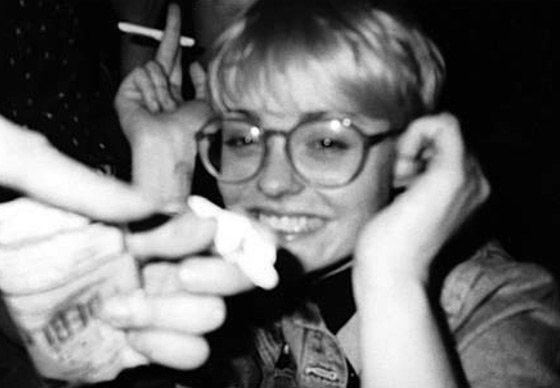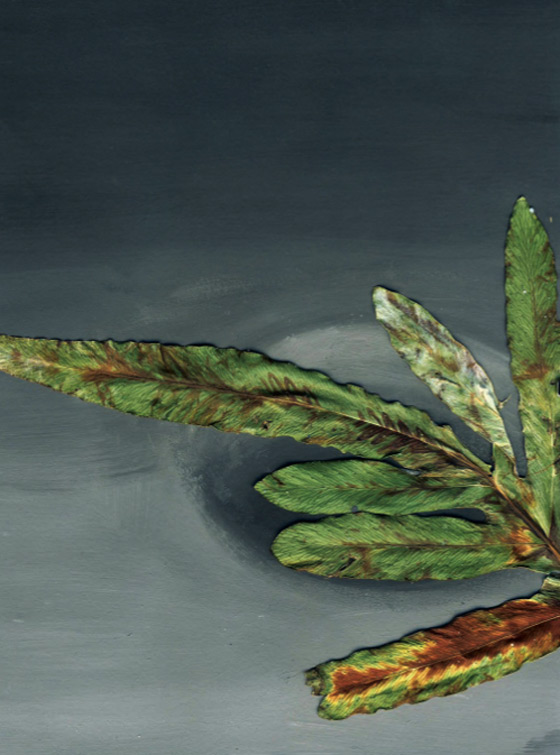|
|
| Ieva Kraukle. Free space for your memories Santa Mičule, Art Academy of Latvia Ieva Kraule. 11 out of 10 19.07.–04.08.2013. kim? Contemporary Art Centre | |
| Ieva Kraule (born 1987) is studying painting at the Art Academy of Latvia. Until now, she has taken part in a number of young artists’ group exhibitions and has presented two solo exhibitions. In her creative work she turns to various media, retaining an interest in the many ways an image can be employed in the creation and deconstruction of the customary narratives of visual art. | |
 Ieva Kraule. 2013 Photo from the private archive of Ieva Kraule | |
| At the end of July, Ieva Kraule’s latest solo exhibition 11 out of 10 at the kim? contemporary art centre presented an exhibition format fairly unusual in Riga art life – a book of photographs placed on a white shelf. The initial impression of a radical minimalism turned out to be misleading, because the exhibition pieces which could be observed and touched were only the visible part of the iceberg, leaving the main contents outside the exhibition space. The works of art which form the conceptual essence were not exhibited, only their documentation was displayed. Thus the exhibition challenged the usual way of presenting and perceiving art, where the documentation is of secondary importance to the concrete object of art. In 11 out of 10 this principle was inverted, because the “real” object (assuming that what could be observed and leafed through in the exhibition hall “only” testified to art) was hard to detect, at the same time existing in various forms – photographs, objects created by the artist, environmental objects, etc. The common element was memories or their impulses, symbolically depicted by the objects in the photographs or coded in the textual explanations accompanying the exhibition. The explicitly personal iconography of the works was not explained, the commentaries being substituted by a widely applied strategy in contemporary art – to permit or even make the audience imagine and choose the explanatory narrative scenarios themselves. By providing an opportunity for the audience to take an active part in the interpretative process, without giving any hints, means that the artist puts aside the privileges of the creator. In this case, the main challenge for the artist is the audience, since a piece of art can achieve its artistic goal only with an interested viewer endowed with a rich imagination. On the other hand, evaluation of the works of art depends on the audience’s capacity for imagination rather than what the artist has created, and in a sense the artist is relieved of responsibility. Another step outside the accustomed was the brochure accompanying the exposition, where instead of information and explanation there was Kaspars Groševs’ essay “Eleven out of ten”, conducting a dialogue with the visual part of the exhibition. The meeting points between the text and what was on display were as veiled as everything else – they were hidden among references to Nadar, Edison, the Impressionists, etc. The everyday objects which Ieva Kraule had created for the exhibition 11 out of 10 were not actually displayed in the kim? space, but had been photographed in special places chosen by the artist, with a preference for general, timeless spaces without concrete form, which any one of us could have experienced. As already mentioned, most of the objects in the photographs were linked by flashes of memories, and by leaving them in a public space after the process of taking photos was over, the artist was in a symbolic sense sharing her memories. Hence the minimalism of the exhibition not only contrasted with its “real” contents, but also implied a paradox because, contrary to the first impression, the limits of the object of the exhibition extended far beyond the book or the exhibition hall. | |
 Ieva Kraule. By The Abyss of Fictious Memories. Paper, gouache, dry leaf. 24x18 cm. 2012 Publicity photo Courtesy of the artist | |
| Returning to the attempt to define what was displayed in 11 out of 10, we have to conclude that it was not a physically palpable object, but a process of interaction for which the closest definition could be – play. The players this time were not only the artist and the viewers, but also the objects which embodied the memories, the places where they had been left, and the very sense of memories. In parallel with the book on show in the kim? space there was another exhibition taking place at an anonymous venue, known only to Ieva Kraule, where the photographed objects could “remain unnoticed and merge with the ensembles of oblivion”. Thus the various perspectives of looking at a piece of art as a witness to the past were mixed up and played upon. That is, the dominating elements in the photograph book were not events, but only objects symbolizing them – shoe laces, a candle with a tattoo, etc. In the images, the boundaries between the real and the fictitious had been blurred, and thus the very possibility of truthfulness in art was placed in doubt. A similar attitude towards truthfulness as a significant aspect of artistic depiction was evident also in Ieva Kraule’s first solo exhibition By the Abyss of Fictitious Memories at the gallery Bastejs (12.10.2012.–10.11.2012). This was an exhibition of collages created from paintings and random photographs showing scenes typical of the so-called “carefree existence” that we have seen in various lifestyle magazines. The works were presented similarly as in 11 out of 10: the photographs were recontextualized – placed in a different setting which was a painted one, not a physical space. Proceeding from the definition of fiction, we have to presume that also its opposite, namely, truthfulness must exist. In Kraule’s first exhibition it was easier to draw the line between “the truthful” and “the fictitious”, mostly because the contrast between the two was visually more accentuated. The photo images she used served as a kind of ready-made, intervening with the artist’s painterly handwriting based on monochrome aesthetics and a deliberately cursory treatment of form. Thematically the exhibition presented an amalgamation of slightly esoteric themes and images typical of pop culture, complemented by various light and sound effects. The visual codes in the exhibition expressed irony about those aspects of contemporary lifestyle where the search for peace and relaxation at times balances on the verge of religious fanaticism. Each of the works was supplemented by a short story in the form of fictional memories, as the titles suggested (author – Kaspars Groševs). The uniting motif in the conceptual explorations of both Ieva Kraule’s solo exhibitions is the theme of memories, yet they do not appear in the shape of concrete autobiographical stories. The artist investigates and reflects on the ways memories are exploited in the contemporary cultural setting generally. Over recent years, art has become permeated by personal experience, both when reflecting on global processes and when escaping to the self-analysis of personal history. A general enthusiasm for the theme of memories is perhaps one of the side effects of the information age, when a subconscious wish to resist the flow of information and to return to contemplation and a more personal, subjective perception comes as a reaction to being over-whelmed, on a daily basis, by a mind-boggling quantity of external information. The basic premise of Ieva Kraule’s works also opposes didactic narration, instead offering a free space for the memories of her audience. From being a passive observer the viewer becomes a constituent part of the exhibition, once again reminding us of the fact that everything takes place in our heads, and art especially. Translator into English: Linda Straume | |
| go back | |







